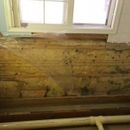What should I use to replace moldy fiberglass batts in exterior bathroom wall?
Hello
I am in the process of replacing shower tile in a main floor bathroom. After removing the tile wall assembly (installed in 1977), I discovered some moldy fiberglass batts covered with a plastic vapor barrier in the stud bays of the exterior bathroom wall. I’m not planning to do any more wall demo at this point, so I’m wondering what the best solution for replacing these batts would be. I would add rigid foam insulation to the interior side of the studs, but then I won’t be able to transition to the rest of the wall.
Any recommendations for what I should do here? Thanks in advance for your feedback. By the way, I am in Omaha, NE and I am just a DIYer – not a pro.
Mike S
GBA Detail Library
A collection of one thousand construction details organized by climate and house part










Replies
Mike,
You're in climate zone 5A. You probably aren't required to bring your wall up to modern code levels, but now is a good chance to do so. That would be a minimum of R-20 batts or blown insulation, or R-13 batts/blown plus R-5 continuous insulation.
What you likely have is common in bathrooms. A mix of air leaks and high vapor drive from interior to exterior pushes moist air into the walls, where it condenses on cold surfaces and supports mold growth.
Mold is a serious issue so I would encourage you at minimum to finish demo'ing the exterior wall finishes, so you can fix the problem properly.
A proper fix would include three things: stop air leaks, provide adequate R-value, and control interior moisture from diffusing into the walls.
Stopping air leaks is usually most easily done at the exterior sheathing. You can use a permanently flexible caulk for this, or there are specialty sprayed products. Canned foam does not usually adhere well in these situations.
The next thing to do is replace the insulation. Mold is a big deal for many people, so be careful, and consider getting a trained remediation person to do it. If it was my house I would use a Tyvek suit and respirator, bag the insulation with a fan running to depressurize the room, and clean the surfaces with a bleach solution. But I'm not a professional remediator.
You can re-insulate with any product you want; they all have pros and cons. Fiberglass can even work well, if installed tightly (the tighter the better) in an airtight space. Mineral wool, cellulose (blown or batts), spray foam, and cut-and-cobble foam are all options for you. Cellulose has some moisture-related qualities that would make it my first choice in this situation, but it would be hard to justify the cost to have a pro do it, so I would probably use Rockwool batts.
At the interior, if your tiles go all the way to the ceiling you won't have much moisture getting through, so the usual advice to use a good variable-permeance membrane doesn't really apply. Are you doing the tile work yourself? You might condier Kerdi Board, which is basically a reinforced foam panel. Or you could use a high quality variable permeance vapor retarder to keep moisture from diffusing into the wall cavities. Pro Clima Solitex Mento is the toughest and easiest to work with. Certainteed Membrain also works fine. Siga's Majrex is also a good product for this situation, though technically it's a uni-directional vapor retarder, not a variable-permeance membrane.
Alternatively, you could install a solid plane of rigid foam at the interior. Zip-R panels would provide insulation and a fastening surface in one shot. But if you're going that route, I would consider the Kerdi Board instead.
These articles and Q+As have additional information you might find helpful:
https://www.greenbuildingadvisor.com/articles/dept/musings/how-design-wall
https://www.greenbuildingadvisor.com/blogs/dept/musings/all-about-wall-rot
https://www.greenbuildingadvisor.com/community/forum/general-questions/104097/bathroom-remodel-question-wall-construction-and-shower-area
Thanks for your response, Michael. I will plan to replace that whole exterior wall in the bathroom. I think I'll go with your advice and caulk the seams between my exterior sheathing and wall studs (there is no exterior insulation). Would a product like DAP Dynaflex work for that?
I've used mineral wool in the past and I like it's versatility for this project. The Certainteed Membrain looks like the most cost effective membrane to use. I am not doing the tile work, but I did request that my installer used the Kerdi waterproofing membrane around the shower/tub. He still wants to use cement backer board vs Kerdi board to adhere the tile to, though.
My final assembly would be as follows then (from interior to exterior):
-tile
-Kerdi waterproofing membrane
-cement backer board
-Certainteed Membrain
-2x4 wood studs with mineral wool batts between them
-exterior sheathing (with flexible sealant at the seams of the studs)
Do you see any problems with that wall?
Michael, sorry I missed your question earlier. Yes, that looks to me like a good assembly.